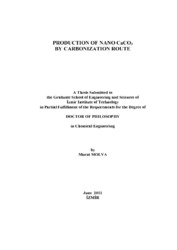Please use this identifier to cite or link to this item:
https://hdl.handle.net/11147/2898Full metadata record
| DC Field | Value | Language |
|---|---|---|
| dc.contributor.advisor | Özdemir, Ekrem | en |
| dc.contributor.author | Molva, Murat | - |
| dc.date.accessioned | 2014-07-22T13:48:34Z | - |
| dc.date.available | 2014-07-22T13:48:34Z | - |
| dc.date.issued | 2011 | en |
| dc.identifier.uri | http://hdl.handle.net/11147/2898 | - |
| dc.description | Thesis (Doctoral)--Izmir Institute Of Technology, Chemical Engineering, Izmir, 2011 | en |
| dc.description | Includes bibliographical references (leaves: 152-163) | en |
| dc.description | Text in English; Abstract: Turkish and English | en |
| dc.description | xxiii, 181 leaves | en |
| dc.description.abstract | Calcium carbonate (CaCO3) is one of the most abundant materials in nature and widely used as filling material in various industries in order to decrease the product costs and to improve some mechanical properties of the composite materials. Because commercial calcite sold in the market is in granular form, in micron size, and inhomogeneous size distribution, the required properties can only be obtained by the recrystallization method. However, because the crystallization is an ionic reaction, there is not a standard procedure to obtain calcite in nano size, monodisperse, and different nano CaCO3 by the carbonization route. In order to understand the progress in crystal formation, crystals were synthesized by the chemical method by slow or fast addition of reactant into the solution. A mini reactor was built in a Ca(OH)2 solution for the carbonization method and reproducible results were obtained. During the precipitation reactions, pH and conductivity of the solutions were monitored. Particles were separated by centrifugation and dried at 103 oC in an oven overnight. Morphological characteristics of the precipitated CaCO3 samples were analyzed by SEM, XRD and FTIR. On the basis of XRD and FTIR analyses, the main crystal form of the precipitated samples was found to be calcite. Colloidal stability tests revealed that these nano particles do form aggregates. It was shown that the crystallization occurs on the surfaces of both the undissolved Ca(OH)2 particles and on the already grown CaCO3 particles as nano calcite evidenced from the XRD patterns of the samples. It was also observed that, in the late stage of the crystallization, because the pH decreased, the morphology of the particles was affected, indicating that erosion took place on the surface due to ionization. The effects of the enzyme, carbonic anhydrase, polyurethane foam, and organic solvents such as methanol, ethanol, toluene, hexane and benzene were also studied. It was observed that, in the presence of solvents nano crystals can be synthesized in the form of calcite, which were mostly monodisperse particles. | en |
| dc.language.iso | en | en_US |
| dc.publisher | Izmir Institute of Technology | en |
| dc.rights | info:eu-repo/semantics/openAccess | en_US |
| dc.subject.lcsh | Calcium carbonate | en |
| dc.subject.lcsh | Calcite | en |
| dc.subject.lcsh | Carbonization | en |
| dc.title | Production of nano CaCO3 by carbonization route | en_US |
| dc.type | Doctoral Thesis | en_US |
| dc.department | Thesis (Doctoral)--İzmir Institute of Technology, Chemical Engineering | en_US |
| dc.relation.publicationcategory | Tez | en_US |
| item.languageiso639-1 | en | - |
| item.fulltext | With Fulltext | - |
| item.openairecristype | http://purl.org/coar/resource_type/c_18cf | - |
| item.openairetype | Doctoral Thesis | - |
| item.grantfulltext | open | - |
| item.cerifentitytype | Publications | - |
| Appears in Collections: | Phd Degree / Doktora | |
Files in This Item:
| File | Description | Size | Format | |
|---|---|---|---|---|
| T000943.pdf | DoctoralThesis | 17.87 MB | Adobe PDF |  View/Open |
CORE Recommender
Page view(s)
104
checked on Jul 22, 2024
Download(s)
76
checked on Jul 22, 2024
Google ScholarTM
Check
Items in GCRIS Repository are protected by copyright, with all rights reserved, unless otherwise indicated.